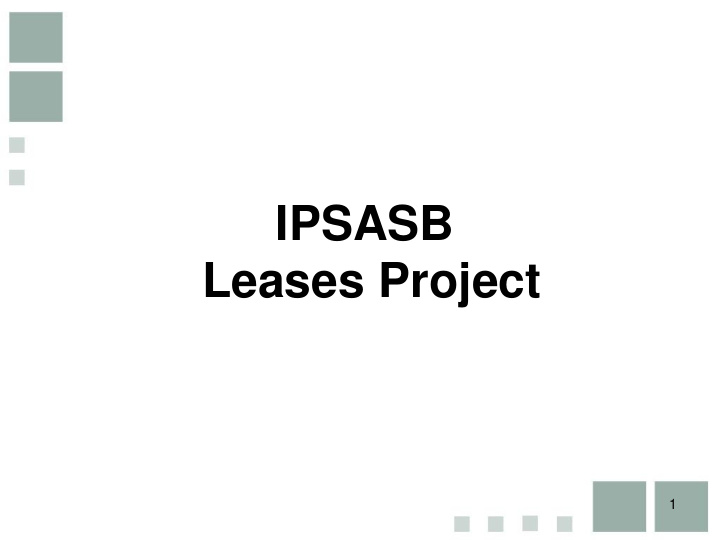



IPSASB Leases Project 1
Development of ED 64 • Leases project is convergence project with IFRS 16 on Leases • New requirements would replace IPSAS 13 on Leases (which was based on IAS 17) • ED 64 proposed the following: – Convergence with IFRS 16 on lessee (ROU) accounting because there was no public sector issues warranting departure; – Departed from IFRS 16 on lessor (R&R), because of inconsistencies with the IPSASB’s Conceptual Framework and control based approach, also consistency in application in public sector; – Separate guidance on concessionary leases • Comment deadline 30 June 2018 2
Proposed accounting: lessee Lessee accounting will change significantly, except for short- term leases and low-value asset leases: IPSAS 13 Proposed accounting Right-of-use Recognise underlying asset Recognise right-of-use asset asset if finance lease Lease liability Do not recognise lease Recognise lease liability liability if operating lease Short-term No recognition exemption Recognition exemption: lease (=<12 months) Account for lease as expense on straight line basis over lease term or Low-value other system basis underlying asset leases 3
Concessionary leases (Lessee) Day 1 • Dr Right of use asset R100 • Cr Liability R60 • Cr Non-exchange revenue R40 (Note: non-exchange revenue could be recognised immediately or deferred, depending on whether conditions exist in the arrangement which require deferral) After initial recognition • If revenue recognised on day 1, no further revenue issues. If deferred, recognise revenue when conditions satisfied. 4
Proposed accounting: lessor Lessor accounting will change significantly, except for short- term leases: IPSAS 13 Proposed accounting Underlying Derecognise underlying Continue to recognise underlying asset asset asset if finance lease Liability Do not recognise liability Recognise liability for unearned revenue (unearned revenue) Lease Do not recognise lease Recognise lease receivable receivable receivable if operating lease Short-term No recognition exemption Recognition exemption: lease Account for lease as revenue on straight (=<12 line basis over lease term or other 5 months) system basis
Concessionary leases (lessor) Day 1 • Dr Lease receivable R60 • Dr Expense R40 • Cr Unearned revenue R100 After initial recognition Recognise revenue according to substance of lease contract: • Dr Unearned revenue XX • Cr Lease revenue XX 6
Overview of responses Source: IPSASB
Proposals received “Lessor Accounting: A World Divided” ED 64 Lessor Accounting 1. Hybrid between ED 64 and Approach 2 2. Retain the R&R model for both lessors and lessees Proposals for 3. Lessor model for all types Lessor Accounting 18% 100% of assets (IFRS 16 or other) 80% 46% 4. IFRS 16 lessor accounting 60% as an additional step on top of ED 64 lessor accounting 40% 33% 5. Extend IFRS 16 finance 20% lease to operating lease 0% 6. Approach 2 (bundle of rights) 3% 7. IFRS 16 Lessor Accounting Agree Partially Agree Disagree No Comment Source: IPSASB
The way forward • Task Force was established to review responses and recommend a way forward for the IPSASB; • No consensus view on lessor accounting; • At March 2020 meeting the Board will be requested to decide on either full alignment with IFRS 16 or to continue with ED 64; • Key issues → reputational risk (alignment vs departure), conceptual vs practical solution and loss of underlying asset information; • Public interest ? lessor should be held accountable for the underlying asset and decisions made on how the asset is used (and by who); 9
Technical Committee’s views on… • Full alignment with IFRS 16 ? – Will still need to provide guidance on concessionary leases (lessor and lessee); • Continue with ED 64 ? – Will need to consider measurement of underlying asset, either the transaction triggers impairment considerations or creates a requirement to use the revaluation model; – Consolidation and mixed group accounting complications; 10
Annexure (for information purposes) 11
Overview of responses Reasons for not supporting departure Rationale for departure not strong enough (R04, R12, R25, R27, R28) Reasons to depart from IFRS 16 are not more prevalent in the public sector or different from the private sector (R04, R11, R12, R27, R33) Consolidation under ED 64 more difficult for public sector entities that apply IFRS (mixed groups) (R10, R12, R16, R25, R27) User information needs in the public sector do not significantly differ from those in the private sector (R10, R36)
Overview of responses Reasons for not supporting lessor accounting There is double-counting of the underlying asset and the lease receivable (R04, R10, R11, R12, R16, R19, R23, R25, R27, R28, R29) The liability (unearned revenue) does not meet the definition of a liability (R10, R11, R16, R25, R27, R29) Inconsistent with the Conceptual Framework (R07, R25, R27, R36) The lease receivable is not a financial asset (R29, R31) Lessor transfers control (R07) of the resource and should derecognize the underlying asset in a finance lease (R10, R11, R28, R29, R33)
Recommend
More recommend